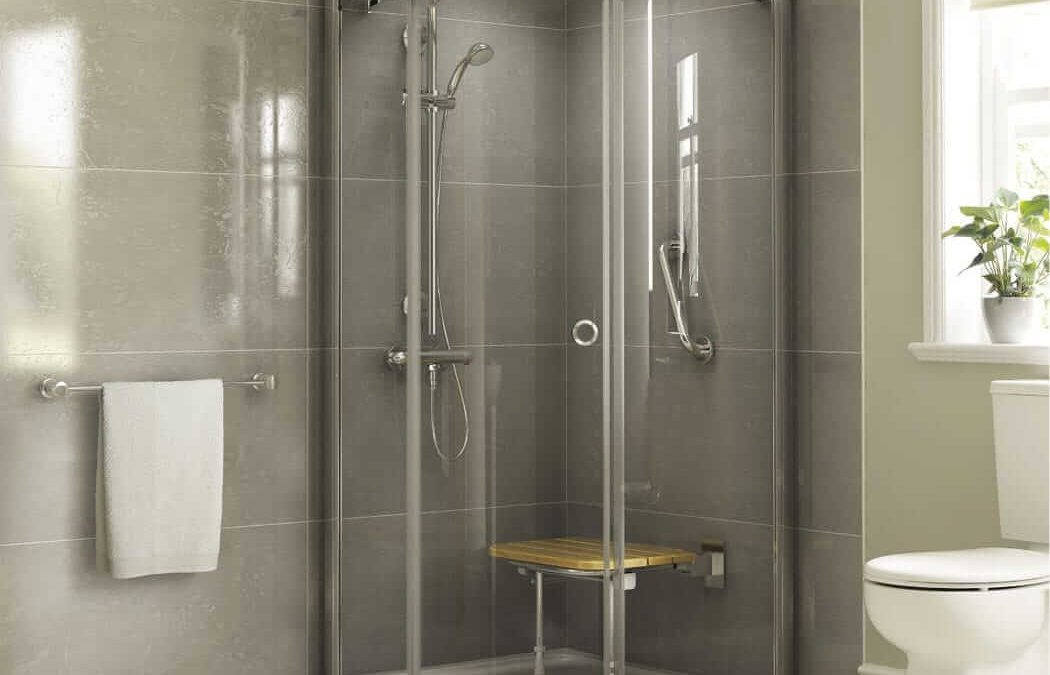
by Jon Pearce | 31st Jan, 2023 | Walk-in showers
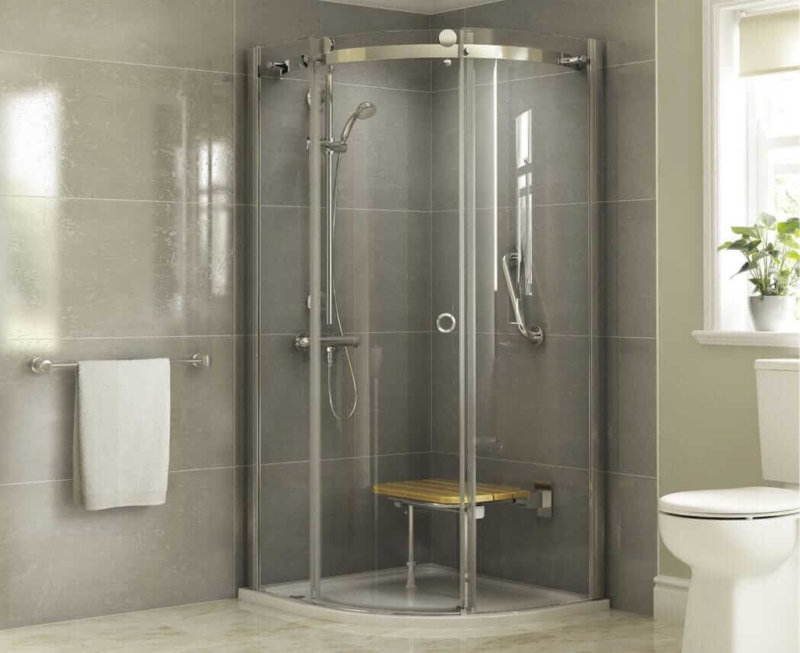
Are you keen to maximise the space you have in your bathroom? Do you have mobility issues making it difficult to get in and out of the bath safely? Well, have you ever thought about replacing the bath with a walk-in shower instead?
Many homeowners of all ages and abilities choose to transform their bathroom space. This improves their comfort and ease by swapping their baths for walk-in showers.
While, of course, it can feel great to have a long soak and relax in the bath. But in reality, how many of us find the time to do it? If your mobility has declined in recent years, or as you’re getting older, you expect it might, then opting for a hassle-free walk-in shower is the most obvious option. Not to mention that showers are a much quicker and more efficient way to wash.
Not sure if changing your bath to a walk-in shower will work for your home and your lifestyle? Check out these seven reasons why you should swap to a walk-in shower and revolutionise your bathroom.
Request a Free Brochure
Simply fill out a quick form and see how we can transform the way you bathe.
Request Free Brochure
- They allow you to reclaim space in your bathroom
- Showers offer increased accessibility for everyone
- It’s a modern and stylish addition to your home
- They can add to your home’s value
- Showers are more water and cost-efficient
- They’re suitable for bathrooms of all sizes
- Showers are much easier to clean
1. They allow you to reclaim space in your bathroom
One of the most popular reasons people decide to replace their bath with a walk-in shower is the space that it can free up. In many cases, the bathroom may be the smallest room in your home. Therefore, you must make the most of the space you have. If you have a bath in your bathroom, then it is likely taking up a lot of space that could be used in other ways. Having a walk-in shower makes your bathroom feel more open and spacious.
This is an even better use of the space in your bathroom if you don’t use your bath often and prefer to shower instead.
2. Showers offer increased accessibility for everyone
Whether you’re struggling with mobility issues or not, showers are a much simpler and more straightforward way to wash than a bath. Therefore, if you are considering changing your bath with a walk-in shower, then you should consider how much easier they are to use.
Not only are showers a lot more accessible and easier to get in and out of, but there are fewer risks attached than when climbing into the bath. There are so many more options regarding sizes and designs. You can choose any kind of shower you like with walk-in showers and wet rooms.
You can even add accessories such as handrails and shower chairs to make them even easier for you to navigate. They’re an especially great option if you are keen to continue living independently as you get older. Replacing the bath with a walk-in shower is a small change to your home that can make a considerable difference.
3. It’s a modern and stylish addition to your home
It is always advisable to keep making changes and additions to your home in order to improve it. From maintenance and DIY projects to modernisations such as getting a new bath or shower. The great thing about wet rooms and walk-in showers is that they are available in a range of bathroom designs. So whatever your taste, you will find the right style for your home.
Many people make the mistake of assuming that wet rooms can only come with tiled floors. While this isn’t always the case, you can still introduce a modern look to tiles with a bright colour or stylish pattern. Swapping your bath with a walk-in shower is a great way to add something new to your home while maintaining a touch of your own taste and personality.
4. They can add to your home’s value
When making adjustments and improvements to your home, you will likely be keen to know what impact it has on your home’s value. While some people worry that installing a wet room may devalue a home, adding a walk-in shower to your bathroom can add value.
Generally, wet rooms are considered to be found in most high-end homes and so is a desirable feature that many people look for when searching for a new home.
For many people that are searching for their forever home, they are keen to find somewhere that can offer longevity. And a walk-in shower is a great way to future-proof a home for the years to come.
5. Showers are more water and cost-efficient
Another great advantage to replacing your bath with a walk-in shower is that showers are better for the environment and use less water. By being able to jump straight into the shower, you won’t have to waste time waiting for the bath to fill up with water.
Instead, a shower means that you will use less water and less electricity and, as a result, cost you less money. So not only does a walk-in shower make it a lot quicker and easier to wash, but it also improves your carbon footprint. And it’s kinder on your bank balance!
6. They’re suitable for bathrooms of all sizes
Keen to replace your bath with a walk-in shower but worried that your bathroom is too small? Many people make the mistake of assuming that they don’t have the space required to make this kind of adjustment. But in reality, showers are a much better option if you have less space to work with.
If you only have a small bathroom, then your bathtub likely takes up a considerable amount of space. Therefore, by swapping it for a walk-in shower you can minimise the amount of space that it takes up. With a walk-in shower, there is no need for any bulky shower doors or shower trays that may take up more space. Instead, you can simply install a shower screen that prevents everything from getting wet. If you have a small bathroom and would like to have more space to enjoy, then a walk-in shower is the best way to achieve it.
7. Showers are much easier to clean
Nobody enjoys cleaning the bathroom but believe us when we tell you that cleaning your shower is a lot easier than cleaning your bath. This is in fact, one of the biggest advantages of installing a walk-in shower, especially if you’re keen to enjoy independent living for as many years as possible.
Without the hassle of shower trays and screens, walk-in showers take a lot less work to clean, and you can still use the same bathroom cleaning products that you usually would. If you choose to get a shower seat installed, then you can even have a sit down while you’re cleaning. Sounds good, right?
Getting a brand-new walk-in shower may seem like a big step to take when it comes to improving your bathroom. But you may be surprised at the huge difference such a small change can make. Whether you want to make life at home a little easier now or you’re thinking about maintaining your independence for as long as possible in the future, replacing your bath with a walk-in shower has a range of benefits.
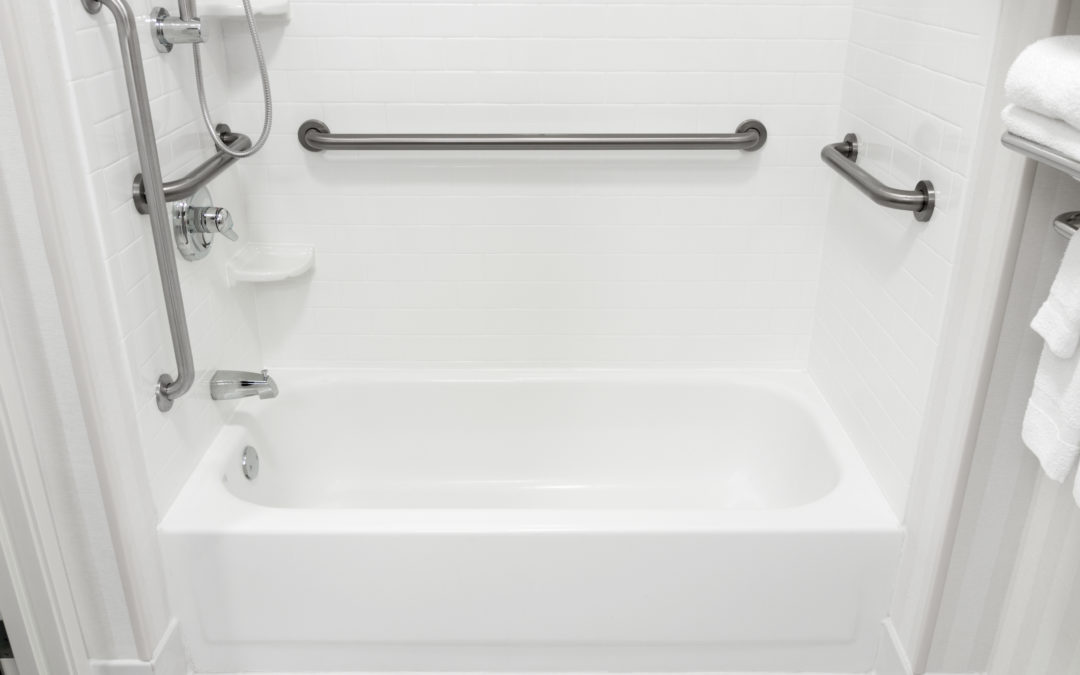
by mobilityplus | 16th Dec, 2022 | Bathroom, Blog
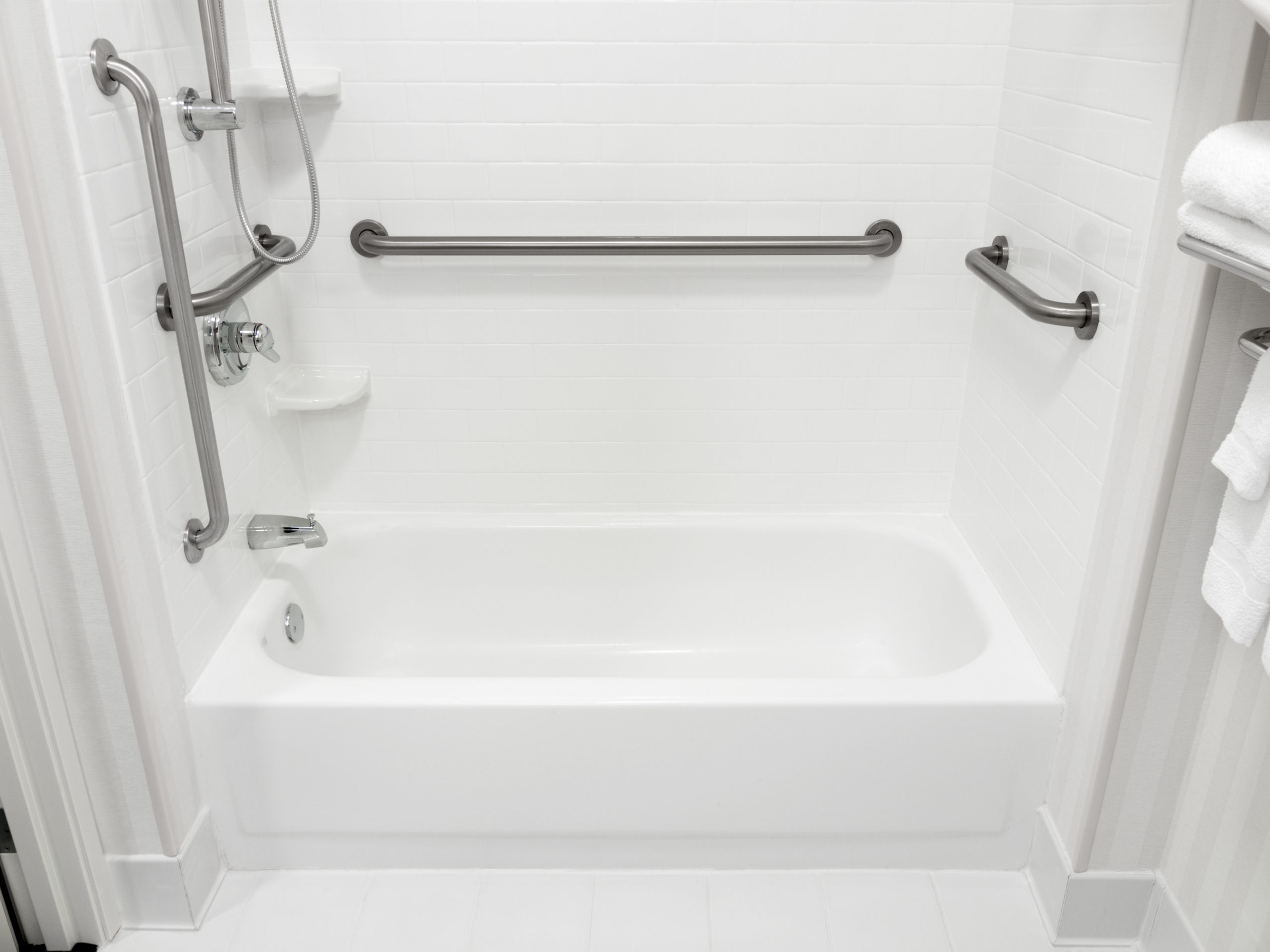
When it comes to enjoying a nice warm bath, personal safety should always be a priority – especially for seniors or anyone with mobility issues. Bathtub railings are designed to help maintain that safety, providing stability and balance as you enter and exit a bathtub, walk-in bath or even a walk-in shower, so you can relax knowing that you have the support you need.
Bathtub railings, also known as grab bars, are bars that mount to the side of a bathtub and allow for easy access. Usually made from stainless steel or plastic, these bathroom safety rails can be installed on walls or floors and provide excellent stability for anyone getting in or out of the bathtub. These railings make a great addition to a bathroom to increase safety.
Request a Free Brochure
Simply fill out a quick form and see how we can transform the way you bathe.
Request Free Brochure
Bathrooms traditionally have tiled or hard flooring. Due to the nature of the room, surfaces can sometimes become slippery when wet, making them a particularly dangerous place to fall. The hard flooring could cause injury, which is why we believe that prevention should always be prioritised regarding personal safety. Studies (source) have found that 60% of the patients presenting in the emergency department are people who are aged 65 and over. It has also been shown that 80% of falls in the home occur in the bathroom, so it is essential that these areas are made as safe as possible.
The good news is that many home amendments can be made to make your bathroom a safe space everyone can enjoy. Adding a bathmat close to baths or showers can help keep your feet dry to prevent slipping. Additionally, adding anti-slip stickers or mats to your bath or shower can provide an extra grip that will help reduce the risk of slips or falls. However, when it comes to bathing, adding railings to the areas surrounding your bath will give you the best support to make manoeuvring yourself in and out of your bath as smooth and steady as possible.
- What types of bath railing are available?
- How your bath railings will look in your bathroom
- Things to consider when you’re choosing a bath handrail
- Do bathtub hand railings improve safety?
What types of bath railing are available?
When it comes to bath railings, there is a wide range on the market.
Wall-mounted rails
Wall-mounted rails are an excellent option for people looking to make some safety modifications to their homes. These rails offer excellent stability and are usually secured directly into your bathroom walls with screws or adhesive.
When it comes to wall-mounted rails, how they are installed can change how they can be used;
- You can use a horizontal rail to push upwards.
- You can use a vertical rail to pull upwards.
- A diagonal rail can be used for both pushing and pulling.
Wall-mounted rails come in a variety of styles. These rails can be made straight, or some types have a bend, a curve, or angled styles, which can provide different grab points for different ways of manoeuvring yourself while you’re in the bath.
Floor fixed rails
Floor-mounted rails are a great alternative to wall-mounted rails, especially for areas where a wall is not close enough to provide the support you need. These are similar to wall-mounted rails in that they are fixed into your floor to give you the needed stability.
Rails that attach to your bath
Rails that attach to your bath are a great option where wall-mounted or floor-fixed rails aren’t suitable. Perhaps you’re moving house and don’t want to modify your bathroom permanently, or you’re away for a few weeks and want an option that can come with you. Railings that can attach to your bath can help provide the flexibility you need on the go or in your home.
How your bath railings will look in your bathroom
While personal safety is your top priority, that doesn’t mean that you can’t or shouldn’t consider how your bathtub railing will look. Due to the extensive range of bath railings available, you will be able to find a bath railing that meets all of your mobility needs while looking aesthetically pleasing and fitting in with the rest of your bathroom decor. Your bathroom should feel like a safe space that you have curated and tailored to meet your needs, and with a range of styles and finishes, you’ll be able to find a bath railing that ticks all the necessary boxes and then more!
Bathtub handrail finishes that you can choose from
- Chrome
- Plastic
- Slip-resistant
- High contrast – This option is excellent for accommodating visual impairments.
Things to consider when you’re choosing a bath handrail
As much as it’s nice to have something that looks nice in your bathroom when it comes to safe bathing, practicality must be a priority. Here are some of the practical things you will need to consider when choosing a handrail:
- How strong is the handrail? Consider what weight your handrail will need to bear, and make sure you check the product description to make sure your rail can meet your needs.
- Grip – Is the handrail material suitable for the bathroom, and does it provide the necessary grip required when wet?
- Is the handrail style the right choice to give you the comfort you need? Consider the placement of your handrail before you commit to a purchase. Make sure you have a clear idea of where you will need it to be positioned to give you the helping hand you need.
Disability applications
Baths with grab rails aren’t just fantastic for seniors; they also provide massive benefits to people who have disabilities that need a little support when it comes to bathing. Handrails are a perfect bathroom modification for anyone who has or is caring for someone with a disability, particularly if the disability affects mobility or vision.
Accessories for bath railings
The range of bath railings available means that you’ll find one that suits you easily. However, you can also get accessories for your bath handrail to make it an even better fit for you and your bathroom. There are styles of handrails that are entirely non-slip; however, you can also buy non-slip covers that can be attached to a particular part of your rail. Having this as a removable option can be beneficial if your bath has multiple users, as while a non-slip surface can give extra grip, it can sometimes be harsh on sensitive skin.
Do bathtub hand railings improve safety?
Senior Health 365 describes handrails as being necessary, not optional, and we agree. Installing a bath handrail can make bathing safer for older people by providing an extra point of stability that can help balance when getting in and out of the bath. It also offers increased safety while in the bath, giving them something to grab onto if they become unstable. Installing rails in your bathroom is a simple modification that can yield such great benefits. Not only for preventing serious accidents but even for making day-to-day mobility that bit easier.
So, yes, bathtub hand railings do improve safety and are recommended by the NHS for those who have mobility issues or a disability.
The team at Mobility Plus are here to help and answer any questions you may have about whether you need a bathtub handrail with your walk-in bath. Get in touch with us today to learn more about how we can work with you to make your bathroom an enjoyable space safe for all to use.

by Jon Pearce | 9th Dec, 2022 | Cancer Research
Staff at Mobility Plus have this year taken part in Christmas Jumper Day to raise funds for both Save the Children and our charity partner Cancer Research UK.
I think you’ll agree that they all looked extremely festive in their various knitwear and with the UK facing some freezing weather, the jumpers also helped everybody stay warm!

Some of the Mobility Plus team showing off their Christmas Jumpers
The team have decided to support two charities, with the UK government promising to double every £2 donation to Save the Children, they were chosen alongside our long-term partner Cancer Research UK.
Both charities do outstanding work and Mobility Plus are very happy to continue supporting them.
Read more about how Mobility Plus supports CRUK’s life-saving research.

by mobilityplus | 22nd Nov, 2022 | Accessibility

Regardless of your age or any disabilities, you should still enjoy independence in your bathroom, whether using a walk-in shower or bath. For those struggling to get in and out of bath, disabilities and age-related conditions can present challenges, but many bath aids for the elderly and other adaptations can help make life easier.
The bathroom, in particular, is an area of the home with many hazards. But by using the right equipment and being aware of these hazards, you can reduce the risk of harm and support those who need it.
This article looks at simple ways to adapt your bathroom space to provide bath help for the elderly or disabled person. These changes can make your bathroom more functional and enjoyable while maintaining a stylish bathroom space.
Request a Free Brochure
Simply fill out a quick form and see how we can transform the way you bathe.
Request Free Brochure
- Be compassionate and maintain dignity
- Making it easier to use the loo
- Install grab rails where needed
- Make the most of a walk-in bath or walk-in shower
- Use slip-resistant mats
- Use a shower seat
- Adjustable or floating worktops
- Install an emergency pull string
- Provide extra assistance
How to help an elderly or disabled person go to the bathroom and improve the space
When using the bathroom, it’s essential to feel safe and secure. The bathroom is a common place to experience slips, falls and injuries; as such, changes are needed to make the space easy to complete everyday tasks.
The NHS advises on the importance of home adaptations to make your space a safer place for everyone. When considering bathing solutions for the elderly, the changes that are made could be big or small, such as:
- Adding a bath lift
- Using a walk-in shower
- Installing multiple grab rails
- Increasing toilet height
- Widening doorways
Before we jump into what changes you can make to your bathroom, there are a few general housekeeping areas to be aware of. Firstly, ensure the bathroom has been fitted with any necessary bathing aids before the individual needs to use it. Ensure this equipment is up-to-date, working correctly and safe to use. Check the room is warm, the water temperature is correct, everywhere is dry, and all toiletries are within reaching distance.
Now, we’ll cover our top nine tips for providing extra bathroom help for elderly/less-abled family members. Remember, these features aren’t just for convenience—they help your loved one maintain their independence, which is a vital aspect of their overall well-being.
1. Be compassionate and maintain dignity
Even with bathroom aids in place, an individual might still need extra support in the bathroom. Assisting a friend or family member can sometimes be a delicate process, so it’s important to respect their dignity and privacy.
If you need to escort someone elderly to the bathroom, ensure you do so at their pace. Before assisting them with whatever they need to do, be sure to chat them through the process and ask permission to help them. This will make the process much easier and more dignified for all involved.
2. Making it easier to use the loo
A standard-height toilet requires individuals to lower themselves further, which can increase the risk of a fall, especially for those also struggling to get in and out of the bath.
A toilet with a higher seat is an excellent addition to your bathroom to improve mobility. It can give the user greater independence and is ideal for those with limited lower-body mobility.
Even better, the height difference is very subtle so that it won’t affect the appearance of your bathroom. If you care for someone with limited mobility, a raised toilet seat can also help you as a carer. The distance between sitting and standing is significantly reduced, making it easier to transfer the user safely.
3. Install grab rails where needed
Grab rails are among the most popular aids for providing bathroom help for the elderly or disabled. They are simple to install, easy to use, and extremely effective.
They’re simple to install and easy to use while being extremely effective. You can install grab rails wherever they are needed in the bathroom and in any position to suit specific needs. They’re especially handy in small bathroom layouts.
A common spot is above the bath, making it easier to get in and out of the tub or shower. Even better, they come in various designs, so you can place one in your bathroom without spoiling the look or decor.
4. Make the most of a walk-in bath or walk-in shower
A walk-in bath or shower pod is a must-have addition to your accessibility bathroom if you’re looking for the best mobility aids. This is a permanent solution to making bathing experiences more accessible and safer.
Walk-in showers or wet rooms are designed to be accessed with ease and feature built-in support such as:
- Grab rails
- Easy temperature controls
- Non-trip shower trays
- More space
The low or no-threshold shower tray makes getting in and out of the shower much safer and more accessible. This is ideal for users with low mobility who still want to maintain their independence when it comes to showering.
A walk-in bath may be more suited to your needs or preferences. These are designed to make the bathing experience safer and more enjoyable for those with a disability or low mobility. Features include:
- Non-slip flooring
- Easy entry point such as low entry doors
- Seating for bathing
- Easy temperature control
Many designs are also stylish and modern, featuring chromotherapy and spa therapy options to make the experience all the more luxurious.
Alternatively, if you don’t want to make such a permanent change to your bathroom but still want to create an accessible bathing experience, you could consider a bath lift. This powered seating device is attached to your bathtub to lower and elevate the user in and out of the tub. They can be used independently or are commonly used to assist carers in helping someone with limited mobility access the bath safely.
5. Use slip-resistant mats
Bathrooms are inevitably slippy, and one of the best and most affordable ways to aid an elderly or disabled person in the bathroom is by using slip-resistant mats. These suctioned rubber mats can be used in the bathtub, shower tray or bathroom floor to provide friction and reduce the chance of slipping. The individuals can then move around the bathroom with more security.
6. Use a shower seat
Shower seats are a no-brainer to improve the safety of the shower area. A foldable seat can be used if your shower is on the smaller side, or you can install a fixed shower seat which allows the user to sit before washing comfortably and securely.
Not only are you taking the weight off your feet, but for those with limited lower mobility, these seats are a game changer to continue enjoying the showering experience. Shower seats are beneficial aids for wheelchair users as they allow for easier access and transfer into the shower.
7. Adjustable or floating worktops
If someone struggles to reach inside a basin, it makes the simple task of washing your hands or face difficult, which can decrease personal hygiene. For example, a wheelchair user needs to get right up to the sink or worktop to be able to use it. The best solution, in this case, is to replace your cabinets or standard sink area with a floating sink or a height-adjustable model.
Floating basins are as simple as they sound. The sink unit is floating with free space all the way to the floor, which allows you to fit a wheelchair comfortably underneath. This is also beneficial for a carer supporting the elderly person, as two people can fit more comfortably into the space.
Another option is to use height-adjustable sinks or worktops that allow you to move the basin to your desired height every time you use it. This is an effective bathroom aid for people with restricted growth, and thanks to its adjustable nature, it doesn’t affect your bathroom decor.
8. Install an emergency pull string
A must-have bathroom aid for any elderly or disabled person is an emergency pull string. These are strategically placed cords that provide an easy and fast way to call for assistance. They’re ideal for bathrooms as you’re unlikely to be wearing a personal form of contact while in the bath or shower.
Once pulled, it will send a signal to caregivers, who can then come to help. This is not only an effective way of keeping the user safe in times of danger, but it can also help to maintain some form of independence too. The individual can be supported as and when they feel they need it but otherwise left alone to complete their everyday bathroom tasks.
9. Provide extra assistance
Some of the most useful bathroom aids are the simplest of all. In some cases, these are the finishing touches that will help the user maintain their independence and use the bathroom alone. Examples could include:
- Reaching aids: These are long pieces of equipment that have gripping jaws on one end and a handle on the other. Once the trigger is squeezed, you can pick up items in the bathroom, such as towels and clothing, without having to overreach and risk falling.
- Tap-turner: These nifty accessories are useful for twisting taps without needing much strength – ideal for those with reduced strength.
- Temperature controls: Easy-to-use temperature controls allow you to control the temperature of your bath or shower with ease. They’re designed in a way that you don’t have to worry about knocking them, and you can focus on manoeuvring safely instead.
In some cases, it may get to the point where physical bathroom aids aren’t enough alone, and your loved one requires extra assistance. At this time, it’s best to employ a carer or train yourself adequately to support the individual.
It’s time to safety-proof your bathroom
You may choose to make quick fixes to your bathroom, such as installing grab rails and slip-resistant mats, or you may opt to make more permanent changes, such as purchasing a walk-in shower or bath. Either way, finding a way to make your bathroom space suitable for elderly and disabled people is important to ensure a confident, comfortable and safe experience.
At Mobility Plus, we specialise in creating an experience that suits your personal needs. Our wide range of walk-in showers and walk-in baths have the very best built-in features to make your bathroom secure while maintaining style too. If you want to talk more about this subject or need advice, please don’t hesitate to get in touch with our friendly team.
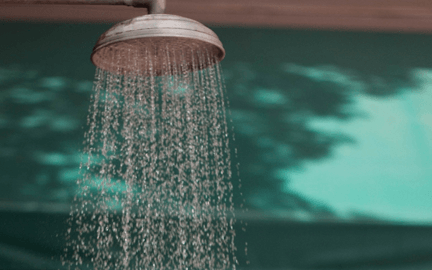
by mobilityplus | 1st Nov, 2022 | Walk-in showers
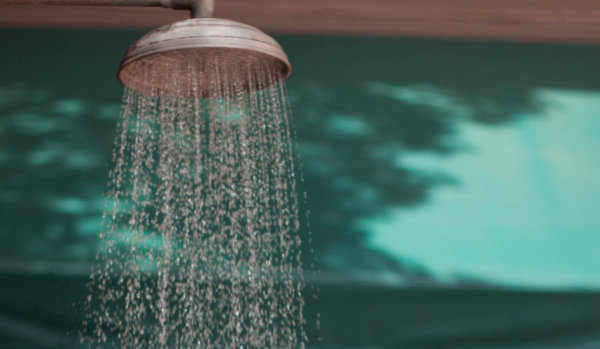
A shower is something we all enjoy. However, difficulty moving, or fear of slipping or tripping can detract from the pleasure of the experience.
If you’re wondering whether to commit to an entire bathroom redesign or simply want a more comfortable showering experience, here’s a short guide to the difference between wet rooms and walk-in showers.
- What is a wet room?
- What is a walk-in shower?
- What should I look for in a walk-in shower?
- The way to stay independent for longer
What is a wet room?
It does exactly what it says on the tin: it’s a whole room for getting wet in! If you enjoy a shower, but like the freedom of an open room, then a wet room is a great choice. There is no step or lip into the shower, access is level with your flooring.
Request a Free Brochure
Simply fill out a quick form and see how we can transform the way you bathe.
Request Free Brochure
A wet room is usually tiled or has waterproof boards from floor to ceiling, with a central drain within the shower area, it may or may not have an enclosure. The whole room is waterproofed, using underfloor tanking to drain the water with no visible tray on show.
They can also add considerable value to your property, although you’ll need a ‘standard’ bathroom as well to tick all the right boxes. They’re incredibly easy to keep clean, too. At Mobility Plus, we understand the complexities involved in installing a wet room, which is why we ensure our expert plumbers and installation specialists are on hand, so your disability bathroom is completed to the highest standards.
If you’re worried about slipping, we only fit slip-resistant flooring when installing any wet room.
What is a walk-in shower?
Again, it does exactly what it says: it’s a shower you can walk into without having to step over the side, greatly reducing the risk of tripping or falling.
The simplest walk-in showers are set up as a stand-alone shower pod with a low-access ‘tray’ at the bottom that allows the water to drain away. For those who suffer from serious mobility issues, walk-in showers that have an enclosed area and seating, as well as grab rails or handles, offer a great support solution. If you decide to opt for a walk-in shower, there are plenty of options to choose from.
They can be easily incorporated into your existing bathroom, so you won’t have to sacrifice an entire room for your mobility bathroom. If you only have one bathroom, then a walk-in shower such as the Richmond level access shower or the Coniston showers with bi-fold doors are ideal since they can be tailored to fit your available space and individual needs. Another benefit of walk-in showers is that they can be reasonably compact and fit into relatively small bathrooms, meaning you likely do not have to change the layout of your bathroom space.
What should I look for in a walk-in shower?
Your personal comfort and safety should always be top of the list.
Walk-in showers are specifically designed to offer you a little more security and peace of mind. Because you sit down in many of them, the risk of falling or slipping is almost eliminated entirely. You also have the option to hold onto the sides of the shower to steady yourself as you get in and out. All of this makes showering a more pleasant and relaxing experience.
If your walk-in shower also has a bath facility, such as the Derwent deep soak walk-in bath range, a fast-fill pump system and a thermostat temperature control system can add an extra layer of practicality and luxury to your bathing experience.
The way to stay independent for longer
Washing is such an essential part of our daily lives that having to rely on others to help you can take away a sense of independence. A mobility bathroom can help you maintain your freedom for much longer, with no compromise on personal safety.
A wet room may be the ultimate in bathing luxury for you. Or you may prefer a walk-in shower, which is small enough to be incorporated into almost any existing bathroom layout.
Whichever mobility bathroom model you choose, it’s entirely down to you and your individual needs. Find out more about how Mobility Plus can transform your bathing experience by talking to one of our experts today. If purchasing a bath is a consideration of yours, also consider taking a look at the walk-in baths we offer.

by mobilityplus | 20th Oct, 2022 | Inspiration
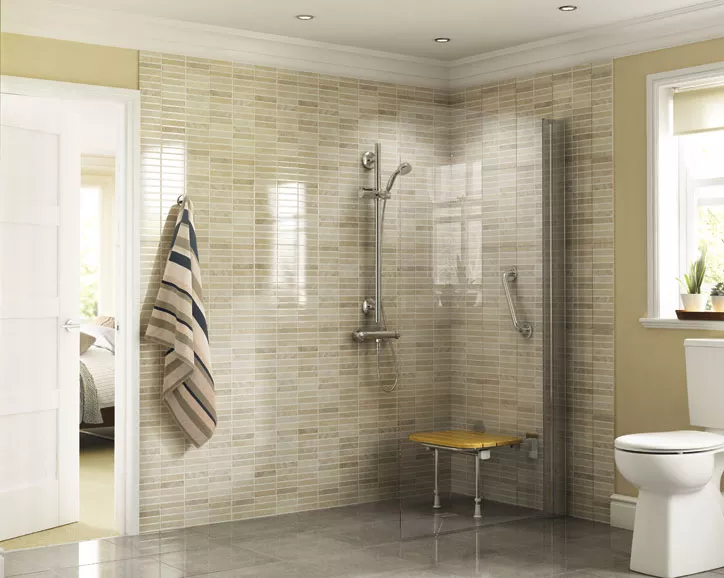
Wet rooms are a stylish, practical option to a shower. Wet room showers do not have a tray that you step over when entering or exiting the cubicle but are on the same level as the floor of the bathroom. This makes wet rooms ideal for those with limited mobility who don’t have to step over the slightly raised surface, and also wheelchair users who can manoeuvre into the showering space with much greater ease.
Despite their high-end look, a wet room can be installed on a budget, and you don’t have to have an exceptionally large bathroom either.
There are wet room solutions available here at Mobility Plus that are cost-effective, space-saving and still stylish. Have a look at our beautiful range and view our wet rooms for small bathrooms, or see which option is best suited to your bathing needs.
Request a Free Brochure
Simply fill out a quick form and see how we can transform the way you bathe.
Request Free Brochure
How does a wet room differ from a walk-in shower?
The main way in which a wet room differs from a traditional walk-in shower is that instead of a having a built-in shower cubicle that includes a shower tray, the room itself forms the enclosure. This enclosure is built to be fully waterproofed, preventing leaks and water damage, complete with drainage for the water to escape.
View our range of wet room showers to see how a wet room can restore your confidence in bathing. We are always on hand to guide you through your options that are suited to your individual bathing needs.
What are the benefits of having a wet room?
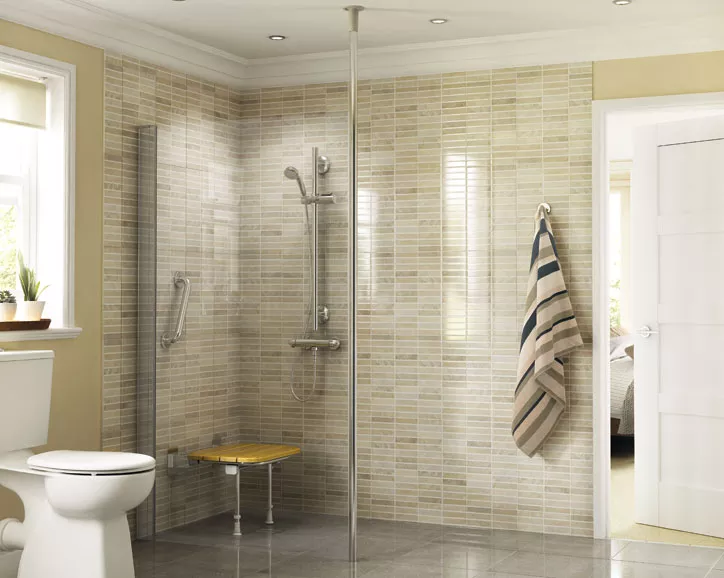
1. Wet rooms are practical for everyday use
Wet rooms are extremely practical, especially for people with mobility issues because they don’t have to step over a bath edge or shower tray. Wet rooms also allow wheelchair access for those with very limited mobility who still want to retain their independence when bathing.
Wet rooms are typically reasonably large enclosures compared to a regular shower, which means carers are also able to assist the person in the wheelchair entering the wet room enclosure. This further makes wet rooms an ideal bathing option for those with limited mobility, and one of the most practical bathing options out there.
The Richmond level access shower range is ideal for individuals looking for a custom-built wet room designed to create a calm and luxurious shower experience. There are lots of door and seating options available, so you can find the best solutions for your bathing needs.
2. Customisability and modularity capabilities
Wet rooms are also hugely beneficial for those who require wide access and who might struggle with showers with bi-fold doors. Customisable options are available, such as grab rails and shower seats. These options aid independent bathing as well as providing extra comfort in your new mobility bathroom.
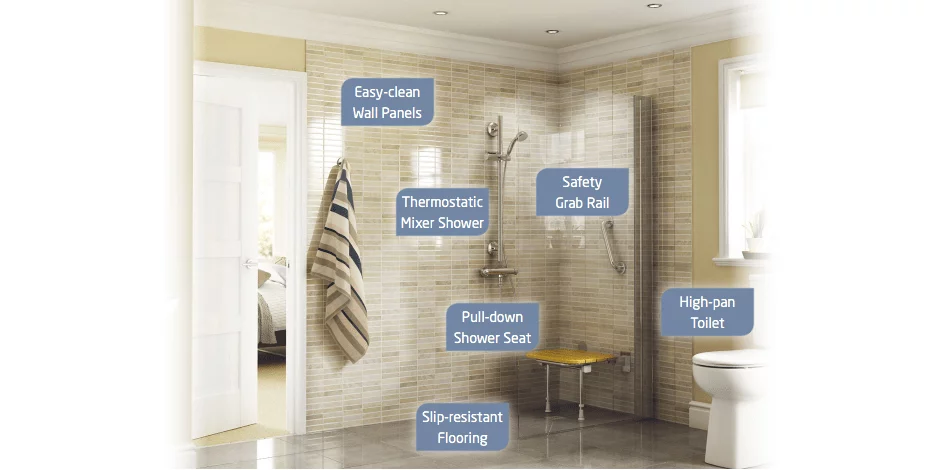
These wet room accessories help to personalise your bathroom, so you can make your space truly your own. Check out our full range of bathroom accessories to customise your mobility wet room according to your bathing needs.
3. Quality and design
As well as all the practicalities of a wet room, the look and style of this bathing experience transform your bathroom into a luxurious, calming, clean and reassuring environment.
This look has grown in popularity after being featured on many interior design programs over the last few years, and bathroom installation companies such as Mobility Plus are making wet rooms much more accessible than they once were.
Take a look at our range of walk-in showers, shower pods and walk-in baths to start designing your mobility bathroom.
Or request your free brochure or quote to see how we could transform your bathroom, so you can bathe safely and with confidence again.













